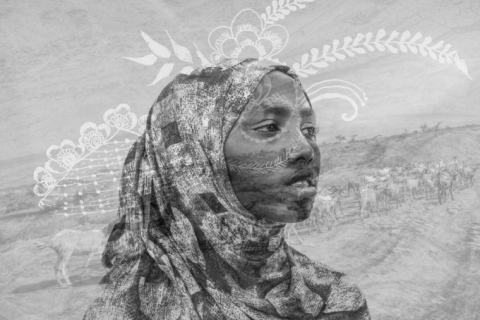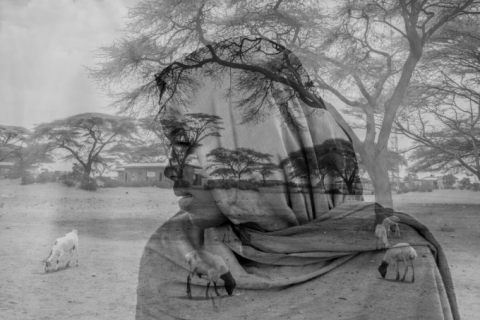Photo series: Child marriage on the frontline of climate change
Double exposure portrait series by Maheder Haileselassie Tadese / Save the Children UK available to download here.
11 October 2023 – On International Day of the Girl, Save the Children has released a series of double exposure portraits by Maheder Haileselassie Tadese, winner of the 2023 Contemporary African Photography Prize, showing the devastating impact of severe drought on girls’ lives in Ethiopia.
Five failed rainy seasons across the Horn of Africa have left up to 20 million people in Ethiopia food insecure. Girls in parts of the country hit by drought and food shortages are increasingly being forced into child marriage, with rates rising by 119% in 2022.[1]
Maheder Haileselassie Tadese spent time with girls in the Somali region, capturing their experiences on the front line of climate change. Bone-dry water sources, decimated crops and dying livestock had combined with vicious conflict to make early marriage a threat to all of them.
Mahader said:
“Listening to the girls’ experiences of child marriage it struck me that each story was linked to the changing climate. Recurrent drought in the Somali region means that the earth no longer provides families with the water and nutritious food that they need. This is why I made the drought-affected landscape and dried river an integral part of each portrait, to represent how child marriage and climate change intertwine.”
The award-winning photographer superimposed portraits of the girls with imagery representing their memories, hopes and fears. The creative images also feature the resources pastoralist families depend on for survival amid the arid landscapes that have wiped them out.

Together these layers represent the factors pushing families towards child marriage along with the strength of the girls and their communities to resist.
Girls who marry young face harsh and far-reaching consequences. They are far less likely to stay in school, with lifelong economic impacts. Child brides are also at greater risk of experiencing dangerous complications in pregnancy and childbirth. They are often isolated, and at higher risk of physical and sexual violence.
A new report by Save the Children – “Girls at the centre of the storm: Her planet, her future, her solutions” – reveals that the number of girls at risk of facing the double blow of climate change and child marriage is set to increase by one third, to nearly 40 million by 2050.[2]
Asma*, was aged 14 when a man expressed his interest in marrying her. As pastoralists impacted by droughts, her parents felt that marrying early could offer her a better quality of life. Supported by Save the Children, Asma* was able to avoid the marriage and now campaigns against early marriage in her community.
“The drought affects my family because our animals are our only income. Before the drought we had milk and meat, but when drought comes there is no milk, there is no meat. And there is a serious problem with scarcity of water and our livestock have no water to drink.
“When I was 14 years old, a man wanted to marry me and my parents agreed. I became unhappy and withdrawn at school, I was depressed. Because he was a wealthier person than us, my parents advised me that if I got married to him my life would become better than theirs.”
Aida*, 20, was married aged 15 after being displaced due to conflict and drought. She was devastated at the time and had to leave school. After a few months in this forced marriage, she became depressed and with the support of her uncle, she fled to the nearby city to escape before returning to live with her family when it was safe.
“Since being displaced, life has been difficult. We used to plough in our fields. We grew and ate whatever we wanted from our garden. Now we have nothing to eat, we are suffering a lot, we live in a shack house and the heat is terrible. We are just living here in the hope that it will pass.
“I was married at the age of 15. My parents married me off thinking our problems would become easier. They gave me to this man to alleviate our troubles. I told them that I would rather die than living with this man.”
Lelo*, 15, avoided early marriage at 14. Her parents agreed to the marriage because their family were struggling economically due to losing their livestock during the drought.
“The land was fertile and green. The animals were healthy and fat. The land was once fertile, but the following year, there was a severe drought. The animals died. Even the plants dried up. I swear the weather changed. Heat, wind, and storms came. When I was 14, I was proposed to. The man proposed to my family, and I was informed when I arrived [home]. I was demoralized.”
‘Girls at the centre of the storm ’ estimates that globally, 80% of people forced to leave their homes by the impacts of climate change are women and girls.[3]
The report also highlights that the situation is likely to get worse – with analysis showing between now and 2030, almost 60% of girls, some 931 million, will experience at least one extreme weather event, like flooding, drought or heatwaves.

Maheder Haileselassie Tadese winner of the 2023 Contemporary African Photography Prize, said:
“I met girls who had been married when they were just 14, forced to leave school because their families were desperate for economic support. For Aida*’s portrait I used images of sorghum and maize, because she described happy memories of her family growing crops and fresh fruits before she was displaced and forced to marry aged 14. When one looks closely, the tree branches on Saeda*’s face look almost like a vein, a metaphor to what trees, land and a good climate means to her and her community. Camels are for her memory of the camels her family lost during the drought.
“But I also wanted to capture the strength and power of the girls campaigning against child marriage. Their determination to help more girls stay in education and fulfil their dreams.”
Xavier Joubert, Country Director for, Save the Children Ethiopia says:
“These powerful photographs illustrate just how vulnerable girls are to extreme weather events like drought. Drought ruins livelihoods, increasing food shortages and poverty. Many girls face the consequences of either having to leave school or marry far too young. No child should lose their childhood to the effects of climate change.
“It’s vital we promote gender equality, put girls at the heart of our climate action efforts and take steps to reduce gender-based violence and child marriage. Governments must increase support to girls and other children most at risk, and above all, accelerate their efforts to end child marriage and stop this abuse of girls’ rights.”
Save the Children has been operating in Ethiopia for over 60 years with its work focused on health and nutrition as well as life-saving water and sanitation assistance, protection services, education support, and cash and in-kind distributions. In 2022, Save the Children reached about 7.6 million people including 5.1 million children.
- ENDS –
NOTES TO EDITORS:
For press enquiries please contact:
- i.turriff@savethechildren.org.uk / +447968858795
- Our media out of hours (BST) contact is media@savethechildren.org.uk / +44(0)7831 650409
References:
[[1]] UNICEF. (2022). “Child marriage on the rise in Horn of Africa as drought crisis intensifies”.
[2] & [3] Save the Children report Girls at the centre of the storm: Her planet, her future, her solutions
[4] Save the Children report Generation Hope: 2.4 billion reasons to end the global climate and inequality crisis here
[5] Save the Children report Born into the Climate Crisis
__________________________________________________________________________
About Maheder Haileselassie Tadese
Maheder Haileselassie Tadese is a self-taught Ethiopian photographer/visual artist born and based in Addis Ababa. In 2023 she won the Contemporary African Photography Prize and has been shortlisted for Grand Prix Images Vevey 2023/24 and Phmuesum grant. Maheder’s works have been exhibited at numerous venues, museums and festivals around the world and she has been accepted to outstanding programs such as World Press Photo Masterclass and New York Times Portfolio review.
Maheder’s work focuses on documenting women's issues, showcasing or celebrating communities that are finding paths to self-sufficiency, as well as exploring rural/urban challenges and potentials that involve youth, health, agriculture or technology.
 Ethiopia
Ethiopia 